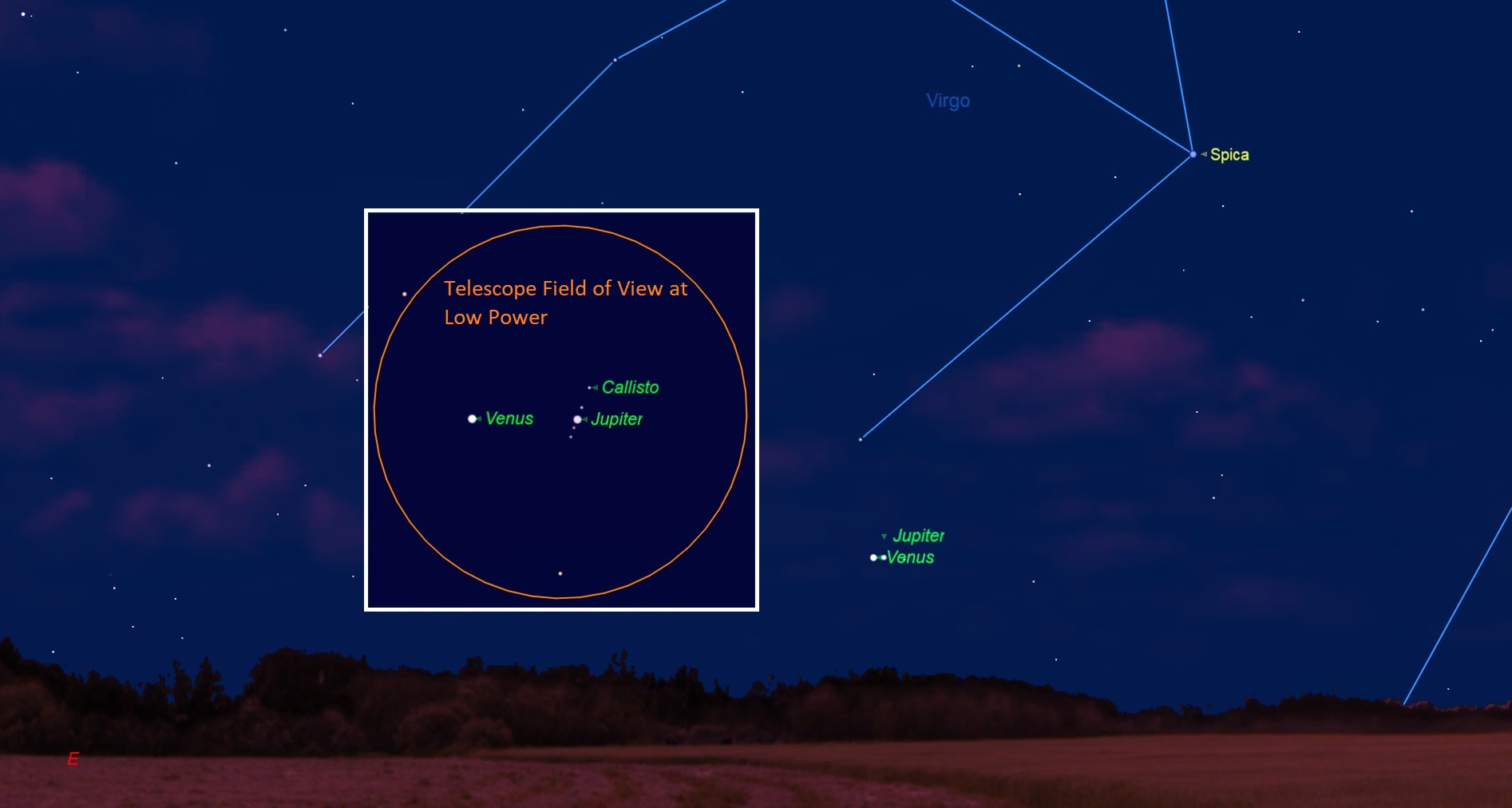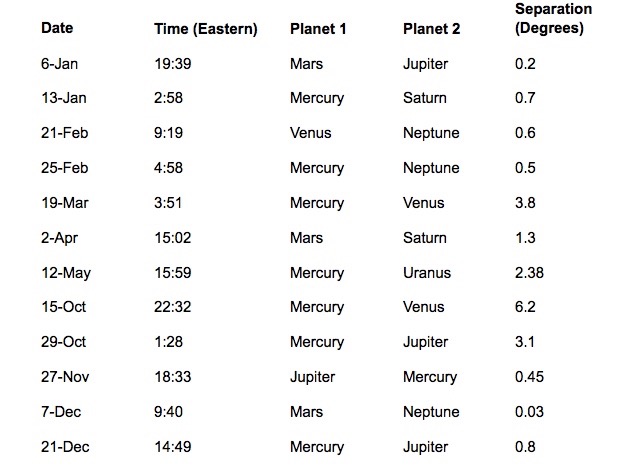Venus-Jupiter Conjunction 2017: When, Where and How to See It Monday
Tomorrow morning (Nov. 13), Venus and Jupiter will rise together in the morning sky, only a few hours after the planets reach "conjunction" at 1:05 a.m. Eastern Time.
Conjunctions occur when two planets share the same right ascension, the east-west longitude in the sky as measured from an observer on Earth. Since the major planets all orbit the sun in nearly the same plane, from the point of view of the Earth, they travel in paths across the sky that are roughly similar.
Therefore, when conjunctions happen, the planets appear close together, usually just a few degrees apart. On Nov. 13, Venus and Jupiter will come within a mere 17 arcminutes of each other, and remain close for a day before and after the conjunction itself. (Reminder: Your fist held at arm's length measures about 10 degrees across. There are 60 arcminutes in 1 degree.) [November 2017 Night Sky: Visible Planets, Moon Phases & Events]
According to timeanddate.com, observers in New York City will see the two planets rise five minutes apart on Nov. 13 — Jupiter at 5:26 a.m. and Venus at 5:31 a.m. local time. The duo will be visible in the constellation Virgo, west of the waning crescent moon, which will be higher in the sky. Observers should look just south of east; the planets will be rising almost exactly ahead of the sun.

Sunrise isn't until 6:40 a.m. in New York on Nov. 13, so if the horizon is relatively flat, one can get a good view until just before daybreak (the sky will likely get too bright to see Jupiter about 15 minutes before dawn). But for anyone with an obstructed view to the east, it will be tricky: Both planets will be just 11 degrees above the horizon when the sun is just out of view.
As one travels east and north, seeing the conjunction gets easier. In London, Venus rises at 5:56 a.m. and Jupiter at 5:58 a.m. on Nov. 13, and the conjunction will occur at 6:05 a.m. The sun rises later than in New York, at 7:15 a.m. local time, so London observers get a full hour and 10 minutes of planet viewing plus the moment of conjunction itself. But here too the maximum altitude is about 11 degrees, which requires a relatively unobstructed eastern view.
For observers west of New York, the conjunction will be well below the horizon when it occurs. In Los Angeles, Jupiter and Venus will rise at 5:18 a.m. and 5:19 a.m. local time, respectively. Sunrise that day occurs at 6:24 a.m., and the two planets will be higher above the eastern horizon than in New York; Venus' altitude will be 12.8 degrees and Jupiter's 12.9 degrees.
Get the Space.com Newsletter
Breaking space news, the latest updates on rocket launches, skywatching events and more!
Southern Hemisphere skywatchers are less well placed for this event; in Buenos Aires, Argentina, the conjunction happens at 3:05 a.m. local time, but Venus and Jupiter don't get above the horizon until 5:08 a.m. and 5:07 a.m., respectively. (In the Southern Hemisphere, their rising order is reversed.) Sunrise is at 5:41 a.m., so there's not much time before it gets too bright out to see the two planets at all, and neither one gets more than 7 degrees above the horizon.
For those who can see the conjunction, however, both planets will be close enough that a wide-field pair of binoculars — as well as some small telescopes and telephoto lenses — should catch them in the same field.
There are some other planetary conjunctions coming up as well. For example, on Nov. 28, Mercury and Saturn will get within 3 degrees of one another. Mercury reaches conjunction with Saturn once again on Dec. 6, and with Venus on Dec. 15. And on Christmas Day, Venus will be about 1 degree away from Saturn.

Editor's note: If you take an amazing photo of Venus and Jupiter, or any other night-sky sight, that you'd like to share with Space.com and our news partners for a possible story or image gallery, please contact managing editor Tariq Malik at spacephotos@space.com.
You can follow Space.com on Twitter @Spacedotcom. We're also on Facebook & Google+. Originally published on Space.com.
Join our Space Forums to keep talking space on the latest missions, night sky and more! And if you have a news tip, correction or comment, let us know at: community@space.com.

Jesse Emspak is a freelance journalist who has contributed to several publications, including Space.com, Scientific American, New Scientist, Smithsonian.com and Undark. He focuses on physics and cool technologies but has been known to write about the odder stories of human health and science as it relates to culture. Jesse has a Master of Arts from the University of California, Berkeley School of Journalism, and a Bachelor of Arts from the University of Rochester. Jesse spent years covering finance and cut his teeth at local newspapers, working local politics and police beats. Jesse likes to stay active and holds a fourth degree black belt in Karate, which just means he now knows how much he has to learn and the importance of good teaching.









